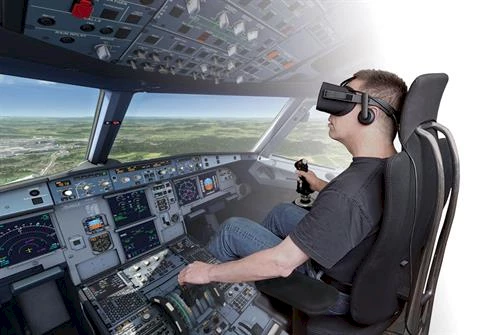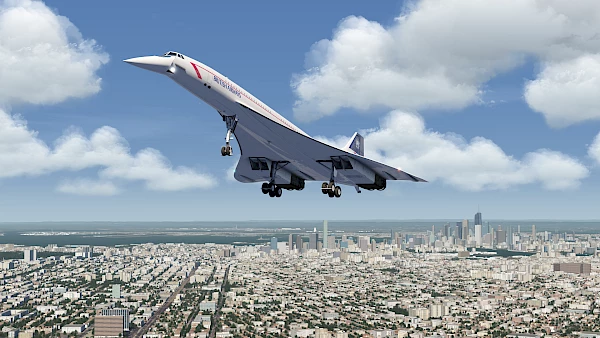Aerofly FS: An In-Depth Look at Its History, Features, and Place in the Flight Simulation Market

Introduction to Aerofly FS
Aerofly FS, developed by IPACS, has established itself as an accessible flight simulator with an emphasis on ease of use, smooth performance, and a user-friendly experience. Although sometimes perceived as a “lightweight” alternative to more mainstream simulators like Microsoft Flight Simulator (MSFS), X-Plane 12, and Prepar3D, Aerofly FS has grown its loyal following thanks to its unique features and performance-driven design. This post will dive into what Aerofly FS brings to the table, the technology powering it, and whether it truly stands up as a competitor in the flight simulation market.

A Brief History of Aerofly FS and Its Evolution
Aerofly FS has a more streamlined history compared to some other flight simulators. Initially released in 2012, Aerofly FS was developed as a desktop and mobile-friendly simulator focused on providing a visually immersive yet simplified flying experience. IPACS, the developer, wanted to carve out a niche for a lighter but visually appealing simulator that emphasized performance without requiring high-end hardware.
Over the years, Aerofly FS has faced criticism for being a “knock-off” of MSFS, as it entered a market dominated by Microsoft Flight Simulator’s longstanding reputation and realism. Critics pointed out Aerofly’s limited global scenery and aircraft options, which seemed minimalist compared to the expansive worlds offered by its competitors. However, Aerofly FS has steadily evolved, particularly with its latest releases, improving both in depth and graphical quality.
Main Features of Aerofly FS
- Visual Quality and Performance
- Aerofly FS has distinguished itself by offering excellent visual quality with impressive rendering of aircraft models and highly detailed environments. Unlike MSFS and X-Plane, which can be resource-intensive, Aerofly’s graphics engine is optimized to deliver smooth frame rates, even on moderate hardware.
- Its visuals, though not as globally expansive as MSFS 2020’s photorealistic satellite imagery, are polished, with a focus on scenic hotspots and popular flight locations, providing a compelling visual experience.

- Physics and Flight Modeling
- Aerofly FS has gradually refined its flight physics, focusing on providing an accessible yet reasonably realistic flying experience. While the simulation may not match the intricate aerodynamics of X-Plane 12 or the professional-level realism of Prepar3D, Aerofly FS still offers a balanced feel that is appreciated by both beginner and intermediate users.
- The simulator has an intuitive flight model, with simplified flight dynamics, making it approachable but limiting its appeal to hard-core simmers who seek maximum realism.
- Aircraft Selection and Detail
- Aerofly FS includes a limited selection of aircraft, each with a high level of visual and functional detail. Notably, it covers a range of aircraft types from general aviation to commercial airliners, along with a few helicopters.
- Aircraft in Aerofly FS are beautifully modeled inside and out. However, the lack of a vast aircraft library and customizable modules limits its appeal for users who want an extensive fleet or specific aircraft found in simulators like DCS or X-Plane.
- Scenery and World Coverage
- Aerofly FS’s world coverage has historically been limited compared to competitors. Instead of offering a full global map, the simulator focuses on regions, including parts of Europe and North America, with impressive terrain and airport detail.
- This approach means that while the scenery quality is often higher within available regions, it lacks the expansive global reach of MSFS 2020 or X-Plane. However, for users who prioritize visual quality over geographic scope, Aerofly’s approach provides a more focused but still immersive experience.
- Joystick / HOTAS – AMAZON.com
- Rudder Pedals – AMAZON.com
- Throttle Quadrant – AMAZON.com
- Gaming Chair – AMAZON.com
- VR Headset – AMAZON.com
- VR Support and Accessibility
- One of Aerofly FS’s strengths is its virtual reality (VR) support. IPACS designed Aerofly FS with VR in mind, offering one of the smoothest VR experiences among simulators due to its optimized engine. The simulator’s ability to run smoothly in VR, even on mid-range systems, makes it popular among VR users who appreciate low-latency, high-fidelity experiences.
- With its accessible interface and streamlined control system, Aerofly FS is an ideal choice for VR newcomers, providing an easy learning curve without the need for extensive hardware.

How Aerofly FS Stacks Up Against the Competition
- Graphics and Environmental Detail
- Microsoft Flight Simulator 2020/2024: MSFS’s use of Bing satellite data and Azure AI for real-time weather and photorealistic landscapes set a high standard. Aerofly FS, while beautiful, lacks the same level of real-world fidelity and dynamic weather effects.
- X-Plane 12: With its advanced weather and lighting engine, X-Plane offers detailed environmental realism. Aerofly, however, offers smoother performance on less powerful machines, making it ideal for users who prioritize frame rate over expansive, data-intensive visuals.
- Prepar3D: Known for its professional-grade features and advanced simulation of environmental effects, Prepar3D surpasses Aerofly FS in realism but requires much higher-end hardware.
- Realism and Complexity in Flight Modeling
- Aerofly FS takes a balanced approach that doesn’t quite reach the realism of X-Plane or Prepar3D but provides an enjoyable flying experience that caters to casual users. In terms of in-depth systems modeling, Aerofly FS falls short compared to the likes of MSFS and X-Plane, which offer a more comprehensive suite of realistic controls, aircraft systems, and failure modeling.
- Community and Modding Support
- One of the factors holding Aerofly FS back is its limited community support and modding capabilities. Unlike X-Plane, which has a robust third-party developer ecosystem, or MSFS with its extensive modding community, Aerofly FS has fewer options for adding new aircraft, scenery, or features. This limitation can make it feel more static and less adaptable than its competitors.
- Add-Ons and Expansions

- The modular add-on structure is underdeveloped in Aerofly FS compared to X-Plane and MSFS, which thrive on their ecosystems of third-party add-ons for everything from aircraft to weather plugins. Aerofly FS has some paid expansions and DLCs, but the variety and quality can be limited, and many users find that the base content does not expand as quickly as in other simulators.
Future Potential and Areas for Growth
Aerofly FS has room to grow, particularly if IPACS can address some of the gaps in realism, world coverage, and modding support. Given its emphasis on performance and visual quality, it could continue to attract users looking for smooth VR experiences and a more casual flight simulation. If IPACS were to invest in expanding the simulator’s regions, adding more aircraft, and opening up to third-party developers, Aerofly FS could potentially compete more directly with larger simulators.
The Complete Beginner’s Guide to DCS World
Welcome to the world of Digital Combat Simulator (DCS World), the ultimate flight combat simulation that brings the thrill of…
Comparing Real World Aviation Procedures to Flight Sim Techniques.
Flight simulators have grown into sophisticated training tools, bridging the gap between virtual flight and real-world aviation….
Mastering Dogfighting in DCS World and Falcon BMS: Max-Perform Your
This post covers essential techniques, cues, and parameters that new combat pilots need to dominate close-range dogfights in DCS World…
X-Plane 12.4 Beta Review – Exciting Additions!
X-Plane 12.4 Beta Review – A Major Leap Forward for Performance, VR & Visual Fidelity Note: X-Plane 12.4 is currently in…
Full Guide: DCS Balkans Map + All Upcoming DCS World
Full Guide: DCS Balkans Map + All Upcoming DCS World Modules. Summary: Eagle Dynamics and OnReTech have officially announced DCS: Balkans,…
DCS World T-45 Goshawk Formation Flying for Beginners Tutorial .
Military Formation Flying in DCS: Your First Flight in the T-45 Goshawk. So, you’ve got your wings (virtually speaking), strapped into…
DCS WORLD T-45 Goshawk EASY Navigation for Beginners.
DCS WORLD T-45 Goshawk EASY Navigation for Beginners is simply that. We do our planning in the DCS World Editor…
How the U.S. Navy Trains Jet Pilots: A Complete T-45
Welcome to Letsflyvfr.com guide to T-45C Goshawk Training – How the U.S. Navy Trains Jet Pilots so you can train…
DCS WORLD – The MB-339 by IndiaFoxtEcho: A Complete Overview.
The MB-339 occupies a very particular niche in DCS World: it’s not a fighter, not a frontline attack jet, but…
- Latest CPU’s Available Now – Amazon.com
- Get a NEW GPU Best Performance – AMAZON.com
- Upgrade RAM Here today – AMAZON.com
- Prebuilt PC Options – AMAZON.com
Final Verdict: A Quality Simulator or a Limited Alternative?
Ultimately, Aerofly FS is a unique offering in the flight simulation market. It excels at delivering high-quality visuals and smooth performance, particularly for VR users and those with moderate systems. However, it remains a “light” simulator that doesn’t cater to hardcore simmers seeking the most realistic and in-depth experiences. Its limited world coverage and lack of modding support mean that it may continue to be seen as a “casual” simulator compared to more robust platforms like X-Plane 12 and MSFS 2024.
While Aerofly FS may not stand toe-to-toe with industry giants, it offers a specialized experience that appeals to users prioritizing accessibility, visual quality, and VR performance. For some, it’s a perfect fit, while for others, it’s a stepping stone toward more advanced simulators.

Author
Brendon McAliece (Aka Gunnie) is a military veteran with 23 years working on Jet Fighters, their weapons systems and ejection seat/module systems as well as munitions and R&D. Involved with flight simulation since the 1980s, he has flown all the major flight simulators over the years.
He is an Australian expat who has lived in Malaysia, UK, Saudi Arabia and more recently Thailand. He is a multi-lingual blogger who loves to share his life experiences here on LetsFlyVFR.com and DreamingGuitar.com, with his lifestyle and Travel experiences Blog plus his Dreaming Coffee website.
Learn More @ DreamingGuitar.com – DreamingCoffee.com – LetsFlyVFR.com
( HOME – BLOG – SHOP – ABOUT )
As an Amazon affiliate I may benefit from qualifying sales.









